Author :
Abstract
Bu çalışmanın amacı, öğretim elemanlarının örgüt kültürünü algılama düzeyini ortaya koymak ve farklı değişkenler açısından incelemektir. Veriler, fakülteler, yüksekokullar ve meslek yüksekokulunda çalışan 142 öğretim elemanının katılımıyla toplanmıştır. Örgüt kültürü algılarını ölçmek için Güven (1996) tarafından geliştirilen "Örgüt Kültürü Ölçeği" kullanılmış ve veriler SPSS 25.0 istatistik programıyla analiz edilmiştir. Analiz sonuçları, çalıştığı birim, akademik unvan, kurumda çalışma süresi, cinsiyet değişkenlerine göre öğretim elemanlarının örgüt kültürü algılarında istatistiksel olarak anlamlı farklılıklar olduğunu ortaya koymuştur. Meslekte çalışma süresi değişkeninde ise varyans analizi sonuçlarına göre anlamlı fark belirlenmiş, ancak ‘Tukey’ testi sonucunda ise anlamlı fark bulunmamıştır. İstatistik sonuçlarına göre örgüt kültürü alt boyutlarına katılım düzeyine ilişkin puan ortalamaları en yüksek düzeyde ‘Törenler-Toplantılar Dil, Maddi Kültür Öğeleri’ alt boyutunda, en düşük düzeyde ise ‘Ödül Sistemi’ alt boyutunda bulunmuştur. Bu bulgular, Kapadokya Üniversitesi'nde görevli öğretim elemanlarının genel olarak yüksek düzeyde bir örgüt kültürü algısına sahip olduğunu göstermektedir.
Keywords
Abstract
The aim of this study is to reveal the level at which academic staff perceive organizational culture and to examine it in terms of different variables. The data were collected with the participation of 142 academic staff working in faculties, schools of higher education and vocational schools. "Organizational Culture Scale" developed by Güven (1996) was used to measure the perceptions of organizational culture and the data were analyzed with SPSS 25.0 statistical software. The results of the analysis revealed that there were statistically significant differences in the organizational culture perceptions of the academic staff according to the variables of department, academic title, working time in the institution and gender. In the variable of working time in the profession, a significant difference was determined according to the results of variance analysis, but no significant difference was found as a result of 'Tukey' test. According to the statistical results, the mean scores regarding the level of participation in the sub-dimensions of organizational culture were found at the highest level in the sub-dimension of 'Ceremonies-Meetings Language, Material Culture Elements' and at the lowest level in the sub-dimension of 'Reward System'. These findings show that academic staff working at Cappadocia University have a high level of organizational culture perception in general.
